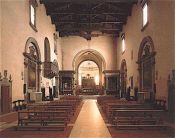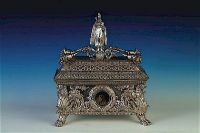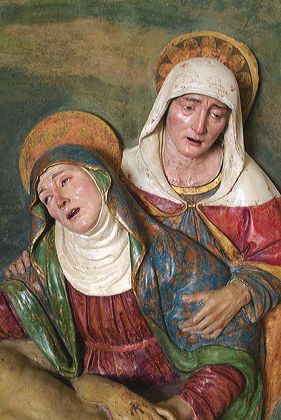Church and Treasury of Santa Maria at Impruneta

The Church of Santa Maria at Impruneta
The Museum of the Treasure of Impruneta is situated in the rooms next to the Church of Santa Maria, an ancient parish church of uncertain date, though it probably already existed before the year 1000. The origins of the church are linked to the legend of the miraculous discovery of a painting of the Virgin Mary, first mentioned by the parish priest Stefano Buondelmonti in 1375. The story is also illustrated in a 15th century marble bas-relief that once formed the frontal for the altar of the Madonna and is now preserved in the Museum of the Treasury.According to the legend, many centuries ago the inhabitants of Impruneta decided to build a small temple dedicated to the Virgin, but they found that they first had to resolve a miraculous event, for the walls they built during the day, always fell down again during the night. The Madonna evidently did not approve of the selected site and so the townspeople decided to entrust its choice to divine justice. A cart full of building materials was harnessed to two oxen who were then allowed to ramble freely around the countryside until, at a certain point, they came to a halt and knelt down, thus indicating the most suitable place to build the temple. A painting on wood of the image of the Virgin was discovered during the work to build the church foundations. According to the legend, it was an effigy painted by St. Luke that St. Romulus, later Bishop of Fiesole, brought to Tuscany from the Orient and then buried, in order to save it during the persecution of the Christians. This ancient tradition is fundamental for fully understanding the significance that the Sanctuary of Impruneta assumed over the centuries.
For Guide books describing the Basilica of Santa Maria at Impruneta and its treasures, see our Books about Impruneta page.
The Church in the 11 C
The first certain information about the parish church dates back to the 11th century, the period in which, in the wake of the revival of the economy and building trade, the older temple (of which no trace remains) was replaced by a larger construction. A plaque in local grey stone fixed to the wall near the entrance to the church is inscribed with the date of its consecration by Umberto di Silva Candida, the papal legate of Pope Nicholas II, in January 1060. The patrons of the new church were the Buondelmonti family, the great feudal lords of the Greve and Pesa Valleys, who always considered themselves its founders and maintained their links with the Basilica until the family died out in the 18th century. Some ruins brought to the light during the post-war restoration have made it possible to determine the plan and dimensions of the ancient Romanesque building which, much smaller than the present church, was divided into a nave with two aisles, three semicircular apses and an underground crypt.The Church in the 14 C and 15 C
The great devotion to Madonna and the ancient local worship of the image preserved in Santa Maria at Impruneta became even stronger in the mid 14th century, thanks to the economic crisis and the Black Death of 1348, and extended well past the borders of the parish as far as Florence. This period marked the parish church's definite transformation into a sanctuary and, as a result, it was completely reconstructed in order to be able to accommodate the crowds of worshippers who came there on pilgrimages. The design of new Gothic church was based on those for conventual buildings, with one wide nave, and, in spite of many alterations, the destruction and restoration in the centuries that followed, this 14th century layout is what we still see today.Important architectural alterations were carried out several decades after the church was newly built, under Monsignor Antonio degli Agli, a scholar and humanist, who was parish priest at the Church of Santa Maria from 1439 to 1477 and later nominated Bishop of Fiesole and Volterra. He was behind all the alterations in the 15th century, from the second cloister to the two small twin temples inside the church carried out by Michelozzo and decorated by Luca Della Robbia. He also built the defensive ring of walls around the entire group of buildings, thus transforming it into an impregnable fortress. The polygonal apse and the two chapels on either side of the transept date instead from the 16th century and were constructed on a commission from Andrea Buondelmonti, who also had many objects of great artistic value created for the church.
Enrichment in the 17 C
The church treasury was notably enriched during the 17th century. This was mainly due to the organisation of the solemn procession that carried the icon of the Madonna of Impruneta to Florence in May 1633 to beg for the end of the plague that had been raging in the city since 1630. The infection ceased soon after and the fervent gratitude of the devout for answering their prayers and bringing about this apparent miracle, showered the church with a great many offerings and votive gifts, some of them of great value. New architectural works on the exterior of the building were started immediately afterwards. The architect Gherardo Silvani built the portico that today adorns the facade in 1634.The miraculous Madonna of Impruneta was carried to Florence once more in 1711, this time at the request of the Grand Duke Cosimo III, in the hope that the divine intervention of the Madonna would save his son Ferdinando. The boy did not survive his illness, in spite of the spectacular procession that moved through the streets of the city centre and was to bring many new and precious gifts to the Sanctuary of Impruneta.
The church was radically transformed again in 1714 in the time of Giovan Battista Casotti, then the parish priest. The interior was restructured by architect Alessandro Saller who modelled it on the Basilica of the SS. Annunziata in Florence. This was an architectural intervention on a large scale, though it was almost totally cancelled out by bombing in the Second World War. When the time came to restore the church (which had been raised to a Basilica in 1925), it was decided to restructure it according to its late Renaissance aspect, partly to satisfy the prevailing tastes of the times, and partly because it was impossible to recover the greater part of the Baroque decorations.
The Museum
The Museum is arranged in the rooms beside the Basilica and divided into three main sections containing the illuminated manuscripts, works in gold and silver, religious vestments and other furnishings connected with its history. The section containing the silverware is hosted in the Silvani Room, where many precious objects in silver and gold are on display and usually grouped together in a uniform series. The 15th century bas-relief illustrating the Discovery of the Image of the Madonna, thus recalling the episode that gave origin to the worship of the Madonna of Impruneta, takes pride of place on the left hand wall in this room.
Click the images for a larger view
The Renaissance
The most significant Renaissance pieces are arranged in the display case opposite the entrance: a partially gilded and enamelled processional cross in silver plate, attributed to Lorenzo Ghiberti (1425 ca.), and carried out in around 1425; two paxes in silver showing the Crucifixion and the Assumption of the Virgin with Christ in Pietà, attributed to Antonio di Salvi and dated 1515, both commissioned for the Basilica by the parish priest Andrea Buondelmonti; and a 16th century pyx in gilded copper.
The most important artistic period to be represented by the art works on display here however is the 17th century. These precious objects include the reliquary of St. Sixtus carried out by the goldsmith Simone Pignoni in 1614 and the silver pyx, dated 1637 and signed by Cosimo Merlini, who decorated it with the Eucharistic symbols of bread and wine. The contemporary altar trapping composed of four candle holders and a cross in rock crystal, works of great quality, were made in the Grand Ducal workshops in Florence and date from the first decades of the 17th century.
The same workshops made the great reliquary cross in silver and rock crystal that stands alone in a glass case on the right side of the room. Made to contain two large fragments of the Holy Cross, it is thought to have been carried out by Cosimo Merlini the Elder for the Grand Duchess Maria Maddalena of Austria in 1620.
The same workshops made the great reliquary cross in silver and rock crystal that stands alone in a glass case on the right side of the room. Made to contain two large fragments of the Holy Cross, it is thought to have been carried out by Cosimo Merlini the Elder for the Grand Duchess Maria Maddalena of Austria in 1620.
Votive Objects
The precious votive vases in silver donated to the church by the metropolitan clergy and some noble families at the time of the famous procession in 1633 form another matching and unique group. The ebony and silver Crucifix on the wall opposite, also carried out in the Grand Ducal workshops, dates from the same period. It is yet another testimonial of the close relations that existed between the Medici family and the Church of Impruneta, to which the reigning family was particularly devoted.The exhibits also include several other objects in silver dating from the 18th century.An elegant bowl with a matching jug, decorated with phytomorphic plant volutes and acanthus leaves, is displayed beside a collection of church furnishings, formed of chalices, pyxes, candle holders and monstrances. They are all of Florentine manufacture, except for the richly decorated chalice, characterised by its repetitive design of heads of cherubs, carried out in Palermo in 1696.
Another altar trapping of Florentine manufacture in embossed and engraved silver is composed of a complete series of six candleholders and a crucifer with a cross. It was created for the altar of the Madonna, it was offered to the Venerated Image of Impruneta by Marquis Cosimo Riccardi on the occasion of the solemn procession in 1711.
Other 18th century religious furnishings include a red velvet silk missal cover with silver appliqué work dated 1702; it is decorated with an Assumption of the Virgin that recalls the worship of the Madonna that, for centuries, has stimulated illustrious commissions and the work of great artists.
Notable among the more recent religious furnishings are the pair of small glass and silver plated ampullae, elegant examples of the Neo-classical taste in Rome between the 18th and 19th centuries, and the pair of early 20th century candleholders, characterised by elegant and typically Liberty floral decorations.
Illuminated manuscripts
The eleven priceless choir books in the section dedicated to manuscripts are only a part of the entire liturgical endowment belonging to the Basilica of Impruneta, one of the few places of worship that has fortunately managed to retain most of its original collection of illuminated manuscripts on site.The manuscripts are divided chronologically into two great groups, illuminated manuscripts of the 14th century and documents decorated in the 16th century.

Gradual, Lippo di Benivieni (attrib.)
The oldest are two books dating from before the third decade of the 14th century, a gradual attributed to the artist Lippo di Benivieni (cod. I), up until now only known as a painter (one of his paintings is preserved in the Museum of Religious Art at San Casciano Val di Pesa); and an antiphonary by a Bolognese miniaturist influenced by Orcagna (cod. II); the latter is distinctive for its extremely severe decoration that reduces the ornamental part to a minimum, with a preference for illustrations of historical or legendary scenes, sometimes placed on top of the corpus of the letter, while the main story is contained within it.
This is followed by a matching group of five antiphonaries carried out by artists from the workshop of Pacino da Bonaguida in around the mid 14th century. This process of transformation was coming to an end in this period and meant that the art of miniature painting was at last freeing itself from the limited function of decorating letters alone. It was now extended to include the illustration of the texts while the small spaces were adapted to suit the same criteria as painting.
This is followed by a matching group of five antiphonaries carried out by artists from the workshop of Pacino da Bonaguida in around the mid 14th century. This process of transformation was coming to an end in this period and meant that the art of miniature painting was at last freeing itself from the limited function of decorating letters alone. It was now extended to include the illustration of the texts while the small spaces were adapted to suit the same criteria as painting.

Antiphony, Antonio di Girolamo di Ugolino (1538-1539)
The four 16th century choir books that can be found in the last two display cases testify to the ulterior evolution in this form of book illustration, three of which were carried out by the same miniaturist, Antonio di Girolamo di Ugolino, on a commission from Andrea Buondelmonti, the former parish priest of the Basilica of Impruneta, who was made Archbishop of Florence in 1532. The illustration of the text in these manuscripts - two graduals and an antiphonary (codexes VIII, IX and X) - is once more limited to the background of the initial letter. Thus the elegant and delicate embellishment has a purely decorative function, like open-worked embroidery, on the sheets of paper. The last codex, the only psalter in the collection (codex XI), has one of its initial letters decorated with the scene of Jonah being saved from the waters; the decorations at the sides are carried out in a wide variety of ornamental, floral and geometric designs and enriched with scrolls bearing weapons and grotesque figures, taken from the decorative repertoire adopted in 16th century painting and sculpture.
Fabrics and Vestments
The next room contains two rare 15th century handmade articles in fabric, found in Bishop Antonio degli Agli's sarcophagus when it was opened after the bombing in 1944 had moved the cover of his tomb. One is a cushion where his head rested and the other the veil that covered his face. They were both carried out, probably by a member of his family, before 1477 (the date of the death of the Bishop) and their early date makes them extraordinary examples of precious textiles in wool and silk.The section dedicated to liturgical vestments is formed of an extremely valuable collection of religious furnishings dating from the 16th to the 18th centuries. An ancient processional tabernacle on the end wall is attributed to the Master of Tobia. Of mid 14th century Florentine manufacture, it is topped with an 18th century crown in silvered brass and gilded bronze. A late 16th century altar frontal in crimson velvet and embellished with gold embroidery can be seen below the tabernacle.
The display cases along the walls running the length of the room contain the small capes of Italian and French manufacture made to cover the image of the Madonna, dating from the 16th to the 18th centuries. They were very often gifts from important families, whose coats of arms are embroidered on the precious fabrics, further enhancing the artistic and documentary value of these objects. They are made out of velvet, brocade and damask, while their decorative motifs testify to the changing fashions in textiles over the centuries.
The collection is completed by a 16th century altar cloth in embroidered gauze of Italian manufacture, arranged in a separate display case, and a series of chasubles, dating from the 16th to the 18th centuries, that are also carried out in a wide variety of fabrics, decorations and coats of arms.




